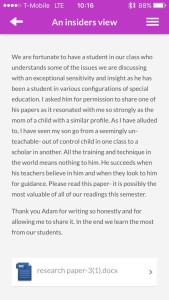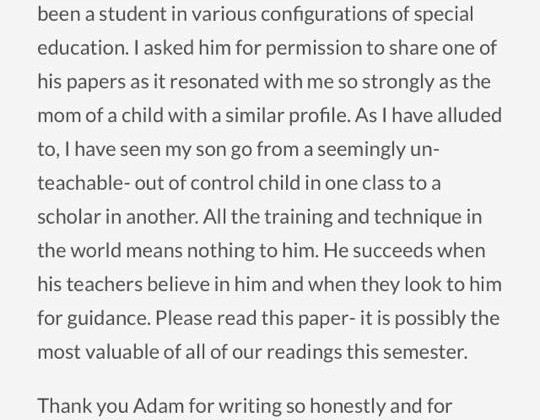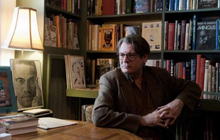I’z a beamin’
 “Special Education is a Service, Not a Place”:
“Special Education is a Service, Not a Place”:
A Closer Look At Autism In Inclusive Settings.
by Adam Thometz
Autism creates a unique set of challenges for any educator and this is especially true in an ICT classroom. There are many reasons for this, including a lack of a common understanding of what autism is and how it affects learning and a lack of knowledge of how to utilize the strengths that autism bestows on someone to enrich the learning experience of everyone in the classroom (only a special educator who is considered truly exceptional may know how to do this while it is not expected that the general education teacher know how to do this). The lack of both understanding and encouragement feeds into prejudice, which leads to a negative perception of students diagnosed with autism, which leads to lower expectations, which eventually leads to the student not living up to their full potential, academically or socially. At that point, it does not matter what style of co-teaching an ICT class is using, as this is merely a technical detail.
It is intuitive to think that an inclusion setting is the answer but growing up in the special education system with the autism label, I have come to realize that not all inclusion settings are created equal (full or partial) and I have become sensitive to how the label has affected the way my teachers perceived me and the instruction that they gave me. Some of my special education teachers were better than others. This essay, while it will not invent a new co-teaching structure or even advocate for a certain established style of co-teaching, serves as a reminder that you cannot educate a student with a disability if they feel lesser than their peers, no matter how you go about co-teaching.
I cannot fully place the blame on my teachers. I was diagnosed with autism in 1992 and started attending kindergarten in 1995. This was a time when autism was not considered as common as it is now, when people were starting to become open to the idea of expanding the definition of autism, when disability studies were not yet prominent, and not long after a civil rights movement for disability had started. In retrospect, my teachers were doing the best they could with the imperfect knowledge and limited awareness that they had. As a tangible concept, autism is a relatively new phenomenon, despite it having been around and part of our gene pool since homo sapiens started to exist. Autism’s definitions have been changing since its linguistic inception, making its definition a constant subject of fiery debate. I would like to give a brief overview of the history of autism in order to give context.
The history of mental health and disability in the United States is dark, no matter what disability you look at. It is full of unsanitary institutions, unsolicited torture, and false cures, with the people usually being condemned from the moment they are diagnosed with something (Whitaker 2002). Meanwhile, autism itself has been around for all of human history, with famous historical figures such as Isaac Newton and Adam Smith thought to have autistic traits, but has never been recognized as a unique state of mind. The people who we would say have Asperger’s today were simply considered eccentric and the more serious cases of what was not yet known as autism were given other diagnoses and were subject to the highly inhumane treatment of mental health professionals. Autism has not been conceived as a tangible concept until 1943, when psychiatrist Leo Kanner first described it as ‘early infantile autism.’ From there, it was lumped in with other mental illnesses and was thought to be the childhood version of schizophrenia, mainly as a result of the narrowness of the definition put forth by Kanner that only included the autistic people to which we refer today as ‘low-functioning’ (Silberman 2015). This was because Kanner was working with patients that were already considered to be in need of psychiatric help so it should be no wonder that the first people to receive the label were already considered mentally ill, which started the reputation of autism as a bleak mental condition to be institutionalized.
With the conceptualizations of Asperger’s Syndrome and the idea of the spectrum in the 1980s, the definition has expanded since then to include ‘high-functioning’ autistic people and other people who have autistic traits but do not need the kind of support that those who are autistic in the traditional sense need. The expansion of the definition of autism is a controversial topic and easily the subject of another essay. For the purposes of this particular essay, it is important to know that autistic communities (which include autistic people and their advocates and are ‘communities’ in the plural due to the diversity of these experiences) have lived in obscurity throughout most of human history due to the stigma attached and now that these voices are out in the open and can communicate through the Internet, they are starting to gain some credibility, although they are still highly stigmatized. As an oppressed group that has lived in silence and has been, and still is, at the mercy of psychiatrists and psychologists, the autistic population, including families and the autistic people themselves, are in dire need of a chance to start over with a clean slate and take back their humanity.
According to my own experience on the spectrum, the only people right now who are willing to let us collectively ‘start over’ are special educators, social workers, school psychologists, and anyone familiar with the concept of neurodiversity, while nearly everyone else, including those who self-identify as progressive[1], continues to believe the negative stereotypes that are perpetuated by the media. Examples of these negative portrayals include Malcolm Gladwell arguing that autistic people are more susceptible to “thresholds of violence,” which make them more likely to engage in a school shooting[2] and Eustacia Cutler, Temple Grandin’s mother, writing an op-ed piece conjuring up a link between autism and child porn consumption.[3] Autism Speaks, the most influential organization that addresses autism issues, has been lambasted by a variety of autism bloggers for promoting hate speech about autism, for funding research that sets out to find a ‘cure,’ and for allocating very little of their funding to services for autism communities[4] [5]. These negative portrayals often find their way into our educational setting, where these prejudices are arguably the most dangerous. I found it harder to shake off the prejudices of autistic people when I was a student in public school than when I became an adult because that was a time when I was reminded that I was a second-class citizen every single day. This is a problem that cannot be addressed by obsessing over what co-teaching style works best overall.
How this seeps into the co-teaching classroom is that you have one person who is most likely more enlightened on the challenges of autism, the special educator, than the other person in the room, the general educator. The general educator comes into the classroom simply knowing how to teach while the special educator comes in both knowing how to teach and how to differentiate instruction for people with disabilities, including those on the spectrum. The general educator may or may not know how to best differentiate instruction for students with autism and other disabilities and may also perhaps hold subtle prejudices that can come out and hold back a disabled student’s education if left unchecked (unfortunately, this phenomenon is not restricted to students with disabilities. Minorities also face debilitating and discouraging experiences in the educational system[6]). This is fine in the sense that this is workable and we should not expect the general educator to have perfect knowledge of autism since our knowledge of it is not perfect to begin with but this is fine only if there is communication going on between the two teachers. If there is no communication, the autistic student is left with an incomplete support system and if there is a crack in the support system, the student will fall through it.
To make the matter more complicated, it is also worth considering whether or not a co-teaching scenario is the best type of placement for a student with a disability at all. While a co-teaching setting is technically the least restrictive environment as mandated by IDEA, a study by Wilson, Kim, and Michaels challenges the notion that a co-taught classroom is truly the least restrictive environment for all students with disabilities. The study contends that on the secondary level, a special needs student in the co-taught classroom is not necessarily better off academically than a special needs student in a resource room or alternate day support setting and it depends on the needs of the student. After testing a sample of 559 special needs students in four different settings (co-taught classrooms, resource rooms, alternate day programs, and no support), they have found no meaningful difference between the four settings and found different kinds of academic performance in all four settings. Their research ultimately suggests two things: that “special education is a service and not a place” and that “emphasis on how students [sic] are responding [as opposed to “the ‘how-tos’ and ‘where-tos’ of education of students with disabilities”] must actually drive practices” (Wilson et al. 2013). It is important to note, however, that the study only looked at academic achievement and did not consider social development, although research has shown that inclusion in co-teaching settings has improved the social development of preschoolers with disabilities (Rafferty et al. 2003).
In my experience, there is some truth to this finding about how what style of co-teaching used is irrelevant. It does not matter whether or not the autistic student is in a co-taught setting, a resource room, or anywhere else, as this is only a technical detail. What matters most is whether or not the autistic student has a solid support system, whether that support system is the student’s teachers, peers, or family. In addressing autistic people in his book on neurodiversity in the educational setting, Thomas Armstrong suggests establishing positive relationships filled with warmth and playfulness from the beginning. This is especially important if the student feels alienated at home and/or has a hard time making friends. Armstrong is an advocate for the Floortime model, in which the child’s way of interacting with the world is accepted, despite it being rudimentary, and is built upon through the educator entering the world of the student and attempting to understand the student’s behavior in terms of their inner life, as opposed to artificially molding desired behaviors as would have been done in the pervasive ABA therapy. Once the student feels accepted, then it is okay to start worrying about what style of co-teaching works best.
Personally, my high school years were a complete blur, as I was unavailable for learning, which impacted my grades. I felt that my support system was not well constructed and I was given services that did not fit my needs. For example, I was given a part-time paraprofessional and I felt absolutely no need to have one. The fact that I was the only one with a paraprofessional out of all the other special education kids was not lost on me and made me feel like I was, for a lack of a better way of putting it, ‘the stupidest of the stupid.’ It did not matter to me what the set up of the classroom was or whether or not there was a special educator in the classroom. The classes I remember most fondly and where I put any sort of effort in were classes where I felt appreciated by the teacher and did not feel stupid. Again, classroom setup is only a technical detail and does not matter in the long-term. What matters most is the relationships you build with your students, disabled or not, and that is what sets them up for life-long learning.
Works Cited
Armstrong, Thomas (2012). Neurodiverstiy in the Classroom: Strength-Based Strategies to Help Students with Special Needs Succeed in School and Life. Alexandria, VA: ASCD.
Rafferty, Yvonne, Piscitelli, Vincenza, & Boettcher, Caroline. (2003). The impact of inclusion on language development and social competence among preschoolers with disabilities. Exceptional Children, 69(4), 467.
Silberman, Steve (2015). Neurotribes: The Legacy of Autism and the Future of Neurodiversity. New York, NY: Avery.
Whitaker, Robert (2002). Mad in America. Cambridge, MA: Persus Publishing.
Wilson, G., Kim, S., & Michaels, C. (2013). Factors Associated With Where Secondary Students With Disabilities Are Educated and How They Are Doing. The Journal of Special Education, 47(3), 148-161.
[1] http://www.theestablishment.co/2016/06/06/how-the-progressive-media-sells-out-autistic-people/
[2] http://www.newyorker.com/magazine/2015/10/19/thresholds-of-violence
[3] http://www.thedailybeast.com/articles/2013/08/05/autism-and-child-pornography-a-toxic-combination.html
[4] https://thecaffeinatedautistic.wordpress.com/2013/03/05/why-i-am-against-autism-speaks-and-you-should-be-too-2/
[5] http://www.autistichoya.com/2012/03/responding-to-autism-speaks.html
[6] http://www.vox.com/2016/1/19/10792720/black-implicit-bias
also see:
Neurodiversity: An Alternative Approach to Education.
by Adam Thometz
My main focuses as a future special educator are disability and neurodiversity, particularly autism, and I would like to use my interest in the prospect of educating an autistic population to outline the best educational philosophy for them. Everything discussed in this paper will mainly be informed by my professional experience working as a mentor for autistic adults, my personal experience as an autistic adult who grew up receiving special education services, and independent research that I have done on the topic prior to this class. One of the goals that I hope to accomplish as an educator is to create a school that addresses the unique needs of the autistic population and the challenges they face. The philosophy outlined here – which will involve the empowerment philosophy and teacher-student partnership outlined in critical pedagogy and the freedom to interact with peers and explore one’s own interests found in the liberal-progressive model – will be the philosophy of this school. I will refer to this hybrid educational philosophy as the neurodiverse approach to education. This style of instruction, influenced by the idea of neurodiversity, is needed because no other educational philosophy effectively addresses the needs of this particular population. I am appalled that no such approach has been discussed yet. It accurately reflects the diversity of the human race in terms of not just gender identities and ethnicities but also brain wirings, it directly addresses the oppression that these students face, it stimulates learning by fostering and catering to the widest range of interests possible, and, by mandate of IDEA, it focuses on creating the “least restrictive environment” for all students.
Before I proceed, I should attend to the valid question of why I am specifically addressing the issues faced by the autistic population in this essay as opposed to any other group or the general student population. In order to create an educational system that works, you need to take into consideration its sheer diversity of the autistic population, let alone all neurotypical and other kinds of neurodivergent[1] students. In order for an educational method to work for such students, you will need an approach that is maximally flexible, empowering, universal, and conducive to the development of individual skill and talent. The case is the same for a neurotypical student body; they would benefit from this approach as well and could even address students who are undiagnosed but still need specialized instruction. As a result, much of the approach that I outline here could easily be used to educate students of other populations and would work especially well in inclusion settings. As inclusion becomes the norm in schools, an approach to education that addresses neurodiversity will be very much needed. Special educators will find the neurodiverse approach especially useful for their students, whether they teach inclusive classes or special education classes. I will now give a (very) brief explanation of autism, its history, and why an entirely new approach to education for this population is necessary.
The history of mental health and disability in the United States is dark. It is full of unsanitary institutions, unsolicited torture, and false cures, with the people usually being condemned from the moment they are diagnosed with something (Whitaker 2002). Meanwhile, autism itself has been around for all of human history, with famous historical figures such as Isaac Newton and Adam Smith thought to have autistic traits, but has never been recognized as a unique state of mind. The people who we would say have Asperger’s today were simply considered eccentric and the more serious cases of what was not yet known as autism were given other diagnoses and subject to the highly inhumane treatment of mental health professionals. Autism has not been conceived as a tangible concept until 1943, when psychiatrist Leo Kanner first described autism in the form of ‘early infantile autism.’ From there, it was lumped in with other mental illnesses and was thought to be the childhood version of schizophrenia, mainly as a result of the narrowness of the definition put forth by Kanner that only included the autistic people to which we refer today as ‘low-functioning’ (Silberman 2015). This was because Kanner was working with patients that were already considered to be in need of psychiatric help so it should be no wonder that the first people to receive the label were already considered mentally ill, which started the reputation of autism as a bleak mental illness.
The definition has expanded since then to include ‘high-functioning’ autistic people and other people who have autistic traits but don’t need the kind of support that those who are autistic in the traditional sense need. The expansion of the definition of autism is a controversial topic and easily the subject of another essay. For the purposes of this particular essay, it is important to know that autistic communities (which include autistic people and their advocates and are ‘communities’ in the plural due to the diversity of these experiences) have lived in obscurity throughout most of human history and now that these voices are out in the open and can communicate through the Internet, there are a lot of conversations to be had, including heated debates about what autism is and whether or not this expansion of the definition is fair. As an oppressed group that has lived in silence and has been, and still is, at the mercy of psychiatrists and psychologists, the autistic population is in dire need of an education that addresses this history.
This dark history, while it is slowly coming to an end, has resulted in a fear of the world in its victims that translates into a lack of motivation to engage with it fully and, by extension, flourish. Yet autism researchers and laymen alike routinely place the blame for lack of success on something supposedly intrinsic to autism, which the population proceeds to internalize. This is a phenomenon that I have seen when I have worked as a mentor for the adults of this population, having to be their advocate, and have also personally experienced. When you feel like you are living in a world that has nothing to offer you and is actively shunning you with an onslaught of double standards, damaging myths, and, when you are in school, bullies, you feel less motivated to participate in it.
An example of a double standard with which autistic people often contend has to do with communication. If you are autistic and you do not understand someone, you are blamed for being incapable of understanding others. If you are autistic and someone does not understand you, you are blamed for being unable to communicate. Either way, an instance of failed communication is understood to be the fault of the autistic person, regardless of who misunderstood whom. Why bother trying to communicate with others when it is said that your communication fails on both sides? The student in this model is therefore oppressed by virtue of the double standards and unwarranted blame, among other factors, and this oppression shows itself in their lack of engagement with the world.
What is the best way to address this issue? The hallmark of the neurodiverse approach is the personal relationships that the students will develop with their teacher and their peers. The benefits of forming relationships with other people for the autistic population cannot be understated. Because of the complications that arise from their sensory issues, their experience of the world is extreme and even scary. As a result, they feel less inclined to make friends and end up withdrawn. Feeling a sense of belonging and comfort in the student’s own body and surroundings will help him or her open up.
The challenge in developing an approach for the autistic population is that one approach that works for one student may not work for another, especially considering that autism is often comorbid with other conditions such as ADHD or generalized anxiety disorder, which further complicates their needs. While diversity is a fact of the neurotypical population as well, the differences are far more pronounced among autistics and it is especially important to remember not to make sweeping generalizations about the population, despite the common label. Dr. Stephen Shore summed it up well: “If you have met one person with autism, you have met one person with autism.” It is foolish to make generalizations about the way the entire population thinks based on the DSM. Because of the nature of teaching neurodivergent students needs to be open-ended, the job of the neurodiverse teacher is, like the Freirean teacher, to develop a trusting relationship with each of his or her students, to empower his or her students while acting as their advocate when needed, and to use his or her best judgment in deciding how to instruct a particular student by accommodating for any special learning needs.
It is also the neurodiverse teacher’s job to create an environment that is maximally comfortable. One way of doing this, in addition to having a good relationship with the teacher, is to create companionship among the students and to have them routinely interact with each other. This will build the autistic student’s social skills. It is also necessary to create an environment that is quiet and free of extraneous sensory stimuli, which can be very disruptive for the student. This falls under a mandate set forth by IDEA, which is that every student, especially those in special education, is entitled to the “least restrictive learning environment.”
Building a sense of community in the classroom and making sure the student’s needs are met will open up the student, who will, in turn, cast off his or her fear of the world and become more open to what it has to offer. Only then could learning take place. I have seen autistic adults consistently held back by fear of judgment, which affects their learning and willingness to try new things, whereas the ones who are the least fearful of judgment interact with the world more freely and thrive. As one could imagine, a small classroom with no more than twelve students is the best environment in which to carry out this style of teaching. It is recommended that the class be neurodiverse as well, having both neurotypical and many kinds of neurodivergent minds in the classroom, including autistic, although this approach could also work with any mixture of minds. This approach will be even more effective if the teacher is a good advocate for the students; it will give them the sense that their existence matters.
So far, I have outlined a few components of the philosophy: the student as a gifted but oppressed member of society, the teacher as a guide, instrument of empowerment, and advocate, and the learning environment as a sanctuary and second home. With these elements in place, the student is ready to grow. How do they grow? What do the curriculum and the methodology look like? It is very simple.
From here, it is a matter of letting the students explore their interests. Like in the liberal-progressive model of education, the best way to teach something is to find a way to make it meaningful to the student. Because autistic people also have unbridled mental energy that they can effortlessly apply to their interests, they need both the freedom to explore their interests in whatever capacity the teacher can provide. Since the autistic person is a curious spirit, there is a very good chance that they come in the classroom with their own interests. In addition to having the freedom to explore their interests, the teacher, following the critical model of education, needs to work to undo the years of oppression done on the population to the best of his or her ability. The teacher can do this by fostering a sense of justice early on, by giving them a voice and a sense that their opinion matters, and by understanding how oppression towards them (ableism) affects them and how they can overcome it.
As outlined, the goals of the neurodiverse model of education include empowerment to become self-advocates, individual growth and development of personal vision, and the development of social skills that neurodivergent students have trouble developing on their own. Bringing together of the social justice drive of critical pedagogy and the pragmatic components of progressive education, neurodiverse education is effective because it addresses issues in education that are becoming more relevant that other models do not consider, specifically the education of students with special needs. Neurodiverse education draws attention to a dimension of diversity that concerns the way individuals think, it addresses the oppression that students face, it follows the mandates of IDEA that make it a law that students with disabilities can access and participate in the classroom, and it liberates the student by allowing for maximum expression of the student’s self by encouraging them to explore their interests. This approach to education is necessary in order to reflect the growing needs of the special education population. I find it surprising that nothing like this approach exists in the mainstream yet but to be fair, we are currently at a point in human history when autism is starting to become recognized as its own legitimate mental state. Our society would hugely benefit from the unique perspectives of this population and now is the time to start.
References
Silberman, Steve (2015). Neurotribes: The Legacy of Autism and the Future of Neurodiversity. New York, NY: Avery.
Whitaker, Robert (2002). Mad in America. Cambridge, MA: Persus Publishing.
[1] Neurodivergent is to neurotypical as queer is to straight

 Jumel Terrace B&B
Jumel Terrace B&B Life Turns Man Up & Down
Life Turns Man Up & Down The Private Library
The Private Library
What a great read to wake up to. ” it addresses the oppression that students face, it follows the mandates of IDEA that make it a law that students with disabilities can access and participate in the classroom, and it liberates the student by allowing for maximum expression of the student’s self by encouraging them to explore their interests.”
I think this law could apply to most students that are in our antiquated systems today.
Thank you, Adam, for a well thought out and written essay on education.